BAFA © 2010. All material here is copyrighted. See conditions above. |
Jeff Thomson,
sculptor, Aotearoa / New Zealand.
|
|
In 1977 I went straight from school to studying painting and printmaking at Elam, the school of Fine Arts in Auckland. It was a four-year degree, and after three years I took a year off and spent a lot of time hitchhiking mostly in the South Island.
Not getting a lot of rides, I ended up doing a lot of walking and through that became aware of and interested in roadside paraphernalia such as roadside advertising, fence posts, squashed animals and letterboxes.
I decided to take a long walk, on which I would put a letter into every letterbox proposing that I make some kind of
alteration in the form of an advertisement for the letterbox.
|
The first walk in 1981 was a five-day one from Bulls to New
Plymouth, about 250 km along the west side of the North Island. For this project, I made several small cut-out shapes of
livestock out of plywood, which I attached to the mailboxes.
On another walk, I picked up a sheet of rusty, red corrugated
roofing iron and made a small cow out of it, which sat on top of a mailbox.
| 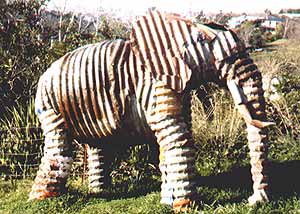
Elephant, 1988, by Jeff Thomson.
|
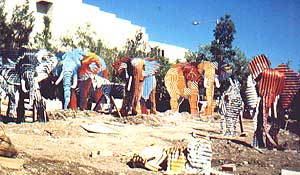 Menagerie for the Brisbane World Expo
Menagerie for the Brisbane World Expo, 1988,
by Jeff Thomson.
| Someone driving past stopped, found out who made it, and commissioned a series of life-size wildlife animals made out of corrugated
iron. They wanted a tiger, penguin and elephant. Someone who saw the elephant commissioned a fence of elephants for their garden boundary. Theyíd had a dispute with the neighbours about the boundary fence and commissioned the elephants to sit with their backsides facing the neighbours.
|
This work got a lot of publicity in the art world, appearing on television and in the national art magazine.
All of a sudden and over the next few years, I got many commissions for tin animals for peopleís homes, and it developed into a full-time business.
Corrugated iron was introduced in Australia and New Zealand during the 1860s for housing on the gold fields and is an integral part of the New Zealand psyche. Twenty years on, Iím still getting many commissions from around the world. At the moment Iím working on a herd of 30 life-size cows for clients in Sydney.
The work is very much a commercial enterprise that flows into the art world. It funds my more experimental projects,
which cover the whole gamut from works for art museums to remote sites.
|
Some projects Iíve done include making a life-size wildlife menagerie out of reused corrugated iron in 1988 for the World Expo site in Brisbane.
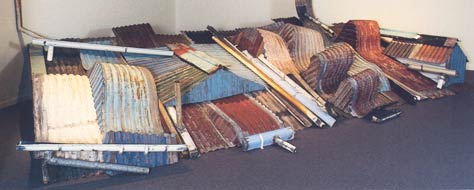
The work is very much a commercial enterprise that flows into the art world. It funds my more experimental projects, which cover the whole gamut from works for art museums to remote sites. Some projects Iíve done include making a life-size wildlife menagerie out of reused corrugated iron in 1988 for the World Expo site in Brisbane.
While making the commissions, I explored working with corrugated iron in a variety of ways, such as stacking, curving, cutting into strips and weaving, cutting into the surface to create lacelike effects, silk screening images onto surfaces, using industrial processes such as rotational plastic moulding (to make unusual shapes), and powder coating (a way of baking protective colour onto the iron surface).
|
|
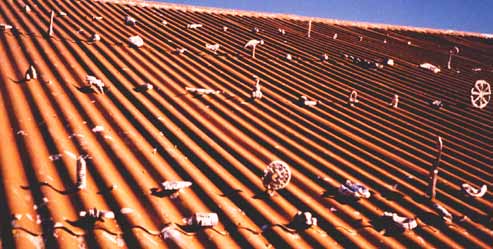
Roof Sculpture by Jeff Thomson, 2000
|

Pirouete Suite, 1994, by Jeff Thomson,
in the Dowse Gallery, New Zealand.
The show was on the theme of windvanes.
Each piece moved in the wind.
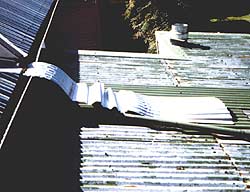 Roof Project in Wanganui
Roof Project in Wanganui 2000.
"I solved the rain flow problems on one roof by creating a system of sheeting that created rapids to slow down and disperse
the water flow. It has been interesting making these roof-related alterations in one small city, because they function more like one
piece or a collection of works."
|
Currently I exhibit several times a year in New Zealand, Australia and Germany. Often these are solo shows involving working on location, where the show becomes an installation space involving various pieces. In these shows the work tends towards the abstract.
While collecting perforated metal such as wire netting from rubbish tips, I realised that I could make my own perforations in the metal by using oxy/acetylene and plasma cutting (which gives a very fine clean cut). I liked the way the physicality of the material was transformed physically and psychologically. The metal looks lace-like and is no longer weatherproofing material.
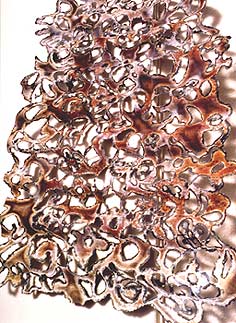
Lace, perforated corrugated iron.
I also collected printed petrol, olive oil and paint tins. These led me to begin silk screening onto flat sheet steel, which I then shaped using various
machines... |
(layout and more images to come soon...)
These led me to begin silk screening onto flat sheet steel, which I then shaped using various machines. Sometimes the designs dominated the forms, such as in the 'Dahlia Suite' (a colourful floral patterned arrangement of roofing products). I've always collected tin plated or pressed metal toys, which have also inspired me. The way they are moulded influenced the 'Suite' series of works. The metal is printed and then press moulded.
|

HQ Holden, corrugated iron car, 1991, by Jeff Thomson.
|
In 1991 I corrugated my car and drove it for three years in New Zealand and for a year in Australia. I received sponsorship from BHP (an Australian mining conglomerate), which covered the cost of the freight across the Tasman. Ironically, at the time I was sueing one of their subsidiaries for copying my work for a television advertisement. I won and spent the money on a world tour.
|
People often copy my work, mostly the animals, so I have to constantly take legal action. I have to do this because the copies are inferior to my work, but are mistaken by the public for my work. I always make sure I document my work well.
"Blue orb" was made for a group exhibition held at the National Art Gallery in Wellington, which looked at New Zealand sculpture. My piece was sited along an isolated area of waterfront and the blocks of concrete (previously parts of buildings now dumped there) were incorporated into the piece. I used very long stretches of corrugated sheeting and curved and wrapped these around and along the angular concrete blocks.
|
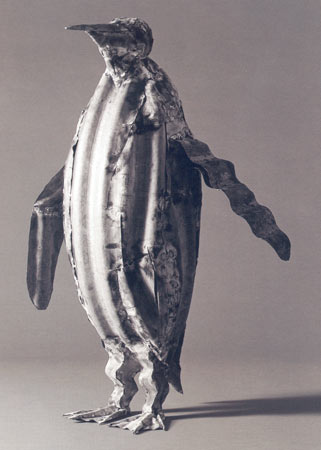
Penguin by Jeff Thomson
|
In 1995 I lived in Dunedin for a year as the Frances Hodgkins Fellow (a year long artist residency) and experimented with printing on metal surfaces. I made a series of tin moulds used for making bread and made bread using them. The moulds were made from guttering, down pipe, ridge caps, and corrugated steel bits. In the installation, "Half Baked", which was made in co-operation with a sound artist Graeme Cornwell, each abstract loaf had a speaker under it that emitted computerised abstracted sounds.
During the year I did a lot of nail making as well. I poured lead into various materials and made them into lead-head nails.
In 1996 I returned to Helensville, 50 km north of Auckland, where I have my studio. I returned to being a full-time artist, working on various projects in New Zealand and elsewhere. In 1997, I did a four-day trip to Holland and Germany to look at a space in the Annalie Brusten Gallery in Wuppertal and to confirm with the director that I was serious about doing the show there later in the year. I had another show there in 1999. It is a dealer gallery so I have to pay my own travel costs and so on. But both shows have lead to shows in public galleries, and one show has been touring for three years.
I was the Tylee Cottage artist-in-residence in Wanganui for six months in 2000. For this project I promoted myself and set myself up as a roofer working in the community. I offered roof alterations, repairs, and restorations for the cost of the materials. I did about 15 large-scale projects in which large areas of roofing was replaced with preprinted sheeting. On one roof I replaced a whole corner of ridging, guttering, corrugated iron and downpipe with a pattern of Greek Kori images chosen by the client.
While in Wanganui, I also made some interior concrete ceiling panels with corrugated patterning for a house and designed three-dimensional forms into roofing structures. I renailed entire roofs with custom-made lead-head nails made from objects on the property. I also used a roof as a site for placing objects, much like exhibiting in a gallery. Other areas I worked on were: rainwater systems, chimneys, ceramic tiles, guttering and downpiping. I solved the rain flow problems on one roof by creating a system of sheeting that created rapids to slow down and disperse the water flow. It has been interesting making these roof-related alterations in the one small city, because they function more like one piece or a collection of works.
|
In a sense I do have a signature in that I work with roofing materials such as corrugated sheeting to make a variety of objects, but my approach always has been and still is experimental. I really have no idea what I will be making in a month's time.
There's a book coming out in November about my work over the past five years, finishing with images from the Wanganui project. It is to be published by the Bowen Galleries (ISBN: 0-473-07315-3, 2000, Published by Bowen Galleries, 35 -37 Ghuznee St., Wellington).
Excerpts from Arts Dialogue, February 2001, pages 2 - 6
|
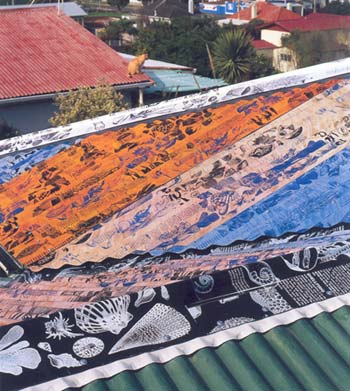
Roof alteration by Jeff Thomson, 2000.
|

Arts Dialogue, Dintel 20, NL 7333 MC, Apeldoorn, The Netherlands
email: bafa@bahai-library.com
|
|










